Davidson Surname Ancestry ResultsOur indexes 1000-1999 include entries for the spelling 'davidson'. In the period you have requested, we have the following 1701 records (displaying 481 to 490): Single Surname Subscription | | | Buying all 1,701 results of this search individually would cost £9,870.00. But you can have free access to all 1,701 records for a year, to view, to save and print, for £100. Save £9,770.00. More... |
These sample scans are from the original record. You will get scans of the full pages or articles where the surname you searched for has been found. Your web browser may prevent the sample windows from opening; in this case please change your browser settings to allow pop-up windows from this site. Boys entering Cheltenham College
(1848)
Cheltenham College 'was founded in order to provide for the sons of gentlemen a Classical, Mathematical, and General Education of the highest order, on moderate terms, in strict conformity with the principles and doctrines of the Church of England.'
Andrew Alexander Hunter, the college registrar, compiled the first edition of the College Register in four parts from 1883 to 1886: these merely listed the boys by term of entry, with their dates of birth and names and addresses of their fathers. Circulars were also sent out to all Old Cheltonians whose addresses were known, requesting additional details. On the basis of the returns from these and Hunter's further researches, this much fuller register was published in 1890.
The information after each boy's name is given (where known and applicable) in this format: father's full name and address as of the time the boy entered the college; class and department on entering the college (classes being number from 1 downwards, and these again divided into A and B, some into C and D, others into P (Principal's side) and V. P. (Vice-Principal's side) - 1A was the highest class in each department: besides this, certain others were called Addiscombe, Woolwich, Civil, Direct, Line, Sandhurst, Naval, Special, Preparatory, Latin, and India Civil) and the same on leaving, name of Boarding House (or 'Day Boy'), scholastic and athletic honours attained at the college, and subsequent career (including date and place of death, or present address in 1890, if known).DAVIDSON. Cost: £4.00.  | Sample scan, click to enlarge
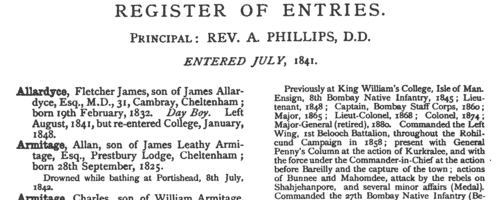
| Boys entering Cheltenham College
(1856)
Cheltenham College 'was founded in order to provide for the sons of gentlemen a Classical, Mathematical, and General Education of the highest order, on moderate terms, in strict conformity with the principles and doctrines of the Church of England.'
Andrew Alexander Hunter, the college registrar, compiled the first edition of the College Register in four parts from 1883 to 1886: these merely listed the boys by term of entry, with their dates of birth and names and addresses of their fathers. Circulars were also sent out to all Old Cheltonians whose addresses were known, requesting additional details. On the basis of the returns from these and Hunter's further researches, this much fuller register was published in 1890.
The information after each boy's name is given (where known and applicable) in this format: father's full name and address as of the time the boy entered the college; class and department on entering the college (classes being number from 1 downwards, and these again divided into A and B, some into C and D, others into P (Principal's side) and V. P. (Vice-Principal's side) - 1A was the highest class in each department: besides this, certain others were called Addiscombe, Woolwich, Civil, Direct, Line, Sandhurst, Naval, Special, Preparatory, Latin, and India Civil) and the same on leaving, name of Boarding House (or 'Day Boy'), scholastic and athletic honours attained at the college, and subsequent career (including date and place of death, or present address in 1890, if known).DAVIDSON. Cost: £4.00.  | Sample scan, click to enlarge
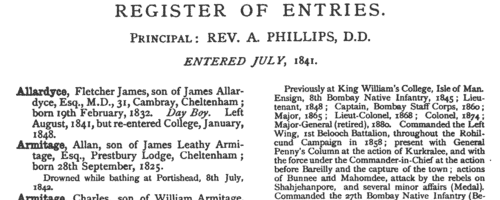
| Boys entering Cheltenham College
(1857)
Cheltenham College 'was founded in order to provide for the sons of gentlemen a Classical, Mathematical, and General Education of the highest order, on moderate terms, in strict conformity with the principles and doctrines of the Church of England.'
Andrew Alexander Hunter, the college registrar, compiled the first edition of the College Register in four parts from 1883 to 1886: these merely listed the boys by term of entry, with their dates of birth and names and addresses of their fathers. Circulars were also sent out to all Old Cheltonians whose addresses were known, requesting additional details. On the basis of the returns from these and Hunter's further researches, this much fuller register was published in 1890.
The information after each boy's name is given (where known and applicable) in this format: father's full name and address as of the time the boy entered the college; class and department on entering the college (classes being number from 1 downwards, and these again divided into A and B, some into C and D, others into P (Principal's side) and V. P. (Vice-Principal's side) - 1A was the highest class in each department: besides this, certain others were called Addiscombe, Woolwich, Civil, Direct, Line, Sandhurst, Naval, Special, Preparatory, Latin, and India Civil) and the same on leaving, name of Boarding House (or 'Day Boy'), scholastic and athletic honours attained at the college, and subsequent career (including date and place of death, or present address in 1890, if known).DAVIDSON. Cost: £4.00.  | Sample scan, click to enlarge
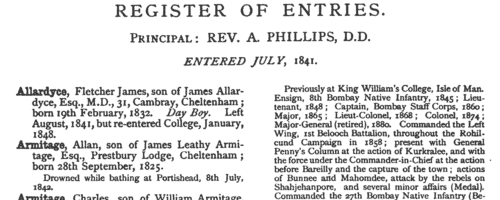
| Boys entering Cheltenham College
(1888)
Cheltenham College 'was founded in order to provide for the sons of gentlemen a Classical, Mathematical, and General Education of the highest order, on moderate terms, in strict conformity with the principles and doctrines of the Church of England.'
Andrew Alexander Hunter, the college registrar, compiled the first edition of the College Register in four parts from 1883 to 1886: these merely listed the boys by term of entry, with their dates of birth and names and addresses of their fathers. Circulars were also sent out to all Old Cheltonians whose addresses were known, requesting additional details. On the basis of the returns from these and Hunter's further researches, this much fuller register was published in 1890.
The information after each boy's name is given (where known and applicable) in this format: father's full name and address as of the time the boy entered the college; class and department on entering the college (classes being number from 1 downwards, and these again divided into A and B, some into C and D, others into P (Principal's side) and V. P. (Vice-Principal's side) - 1A was the highest class in each department: besides this, certain others were called Addiscombe, Woolwich, Civil, Direct, Line, Sandhurst, Naval, Special, Preparatory, Latin, and India Civil) and the same on leaving, name of Boarding House (or 'Day Boy'), scholastic and athletic honours attained at the college, and subsequent career (including date and place of death, or present address in 1890, if known).
Of course, in the case of these boys entering the school in the last few years before 1890 their career lay in the future, and the information gives relates only to their parentage and their time at school.DAVIDSON. Cost: £4.00.  | Sample scan, click to enlarge
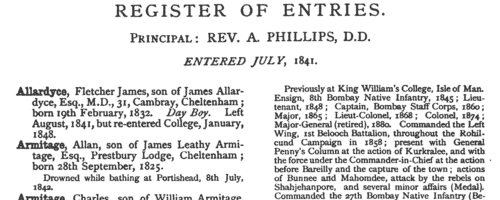
| Estates of the Deceased: Notices under the Trustee Act
(1950)
Under the Trustee Act 1925 s. 27, notices were gazetted giving the names of deceased (surname first, in capitals); address, description, and date of death; names, addresses and occupations of persons to whom notices of claims against the estate were to be given, and names (in brackets) of personal representatives; and the date on or before which notices of claim were to be given. July 1950.DAVIDSON. Cost: £4.00.  | Sample scan, click to enlarge

| Crystal Palace Company Shareholders
(1856)
The management of the Crystal Palace, built for the Great Exhibition of 1851, was restructured by a Deed of Settlement in 1852, and then incorporated as the Crystal Palace Company by royal charter in January 1853. This alphabetical list of shareholders was published in January 1856.DAVIDSON. Cost: £4.00.  | Sample scan, click to enlarge
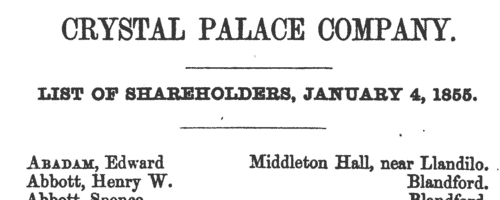
| Laurel Bank School Old Girls
(1952)
Laurel Bank School for girls was opened near Glasgow University in 1903 by two Scottish women graduates. For the half-centenary celebrations in 1953 a history of the school was published, including this 'Who's Who' of old girls, compiled by Mrs Christine White. The names are listed alphabetically by surname and christian name (in capitals), with married surnames in brackets; dates at school; degrees or awards; career, and war service (War); children (Ch.); grandchildren (G.ch.); present occupation (Occ.); and address. We have indexed this on both maiden and married surnames.DAVIDSON. Cost: £6.00.  | Sample scan, click to enlarge
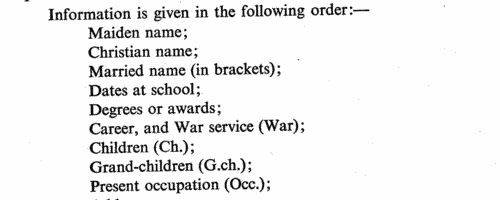
| Boys entering King William's College, Isle of Man
(1915)
King William's College at Castletown on the Isle of Man was established in 1830. By 1928 about 290 boys were being educated there, 'of whom three-fourths are boarders, and the remainders sons of natives or residents in the Island.' Boys entered the junior school about 9 or 10 years of age, the upper school about 13; boys over 13 were not admitted 'unless attainments and character are specially satisfactory'. There were 'several nominations for the sons of clergy and others'.
Editions of the college register were published in 1905 and 1927. When this third edition was prepared, in 1956, it was felt unnecessary to repeat the whole of the register from 1830 onwards, a new starting point being chosen as September 1886, when the reverend Frank Bridgman Walters took office as principal.
The items are arranged alphabetically within term of entry; surname is given first, in bold, and then full christian names; then, to the right, in bold, precise date of birth, school house, and month of leaving the school. The abbreviations for houses are: C, Colbourne; D, Dickson; H, Hunt; Ha, Hangoside; J, Junior House; R, Raglan; S, School House (formerly Principal's); T, town houses occupied by masters who took in boys prior to September 1889; Tr, Trafford's; W, Walters.
Each entry then gives the boy's father's name (surname and initials) and address at that time; school honours (such as Prae., praepositor, XI, school cricket team); a career synopsis; and finally, in italics, to the right, year of death, or present address in 1956, if known.DAVIDSON. Cost: £4.00.  | Sample scan, click to enlarge
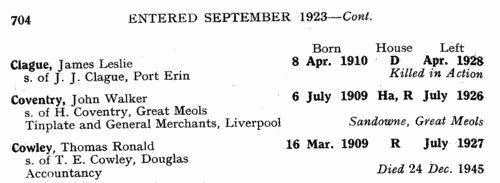
| Boys entering King William's College, Isle of Man
(1935)
King William's College at Castletown on the Isle of Man was established in 1830. By 1928 about 290 boys were being educated there, 'of whom three-fourths are boarders, and the remainders sons of natives or residents in the Island.' Boys entered the junior school about 9 or 10 years of age, the upper school about 13; boys over 13 were not admitted 'unless attainments and character are specially satisfactory'. There were 'several nominations for the sons of clergy and others'.
Editions of the college register were published in 1905 and 1927. When this third edition was prepared, in 1956, it was felt unnecessary to repeat the whole of the register from 1830 onwards, a new starting point being chosen as September 1886, when the reverend Frank Bridgman Walters took office as principal.
The items are arranged alphabetically within term of entry; surname is given first, in bold, and then full christian names; then, to the right, in bold, precise date of birth, school house, and month of leaving the school. The abbreviations for houses are: C, Colbourne; D, Dickson; H, Hunt; Ha, Hangoside; J, Junior House; R, Raglan; S, School House (formerly Principal's); T, town houses occupied by masters who took in boys prior to September 1889; Tr, Trafford's; W, Walters.
Each entry then gives the boy's father's name (surname and initials) and address at that time; school honours (such as Prae., praepositor, XI, school cricket team); a career synopsis; and finally, in italics, to the right, year of death, or present address in 1956, if known.DAVIDSON. Cost: £4.00.  | Sample scan, click to enlarge
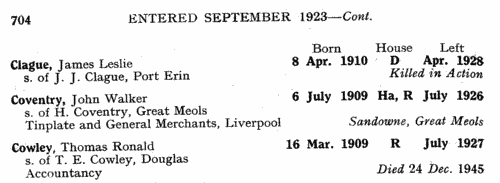
| Ex-Apprentices of British Thomson-Houston Company
(1951)
In 1938 the British Thomson-Houson Co Ltd of Rugby first published a 'record of those who embarked upon careers in the Engineering Industry by way of the British Thomson-Houston Company's Training Scheme': this enlarged edition was issued in September 1951, based on data verified up to December 1948, with subsequent corrections up to the time of printing. The company had been training apprentices since 1899.
The names of the deceased were printed in italics: the most vestigial entries in the volume simply give full name, and the years of apprenticeship; but most entries are much more comprehensive. The symbol 'w' indicates killed by enemy action.
In the first column full name is given in bold, surname first (in capitals), and then any title, decorations, academic qualifications in italics. Beneath that is current address (as of 1951); and then (to the left) year of birth, and (to the right) nature of course followed and years (e. g. 30-32 for 1930 to 1932) of commencement and completion. The abbreviations for the courses are: C, Craft Apprentice; Ch, Chemist Apprentice; Cl, Clerical Apprentice; D, Drawing Office Apprentice; E, Engineering Student Apprentice (Engineering Apprentice up to 1947); G, Graduate Apprentice (Student Apprentice up to 1947); (s), Special Course; T, Testers' Course; V, Vacation Student; W. O., Works Office Apprentice.
The second column gives particulars of academic training, war service, and miscellaneous information.
The third column gives positions held in the past (printed in italics) and present position (as of 1951) where known.DAVIDSON. Cost: £4.00.  | Sample scan, click to enlarge
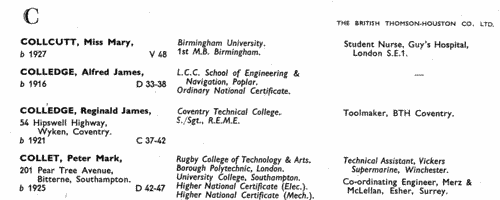
|
Research your ancestry, family history, genealogy and one-name study by direct access to original records and archives indexed by surname.
|












